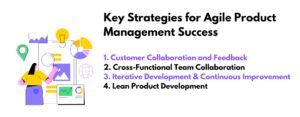Are you ready to drive rapid growth and outpace the competition in today’s dynamic business landscape? How can you stay ahead of the curve and deliver exceptional products that meet customer needs? The answer lies in Agile Product Management.
In today’s rapidly evolving business landscape, staying ahead of the curve is crucial for sustained success. Agile Product Management has emerged as a powerful framework that enables organizations to accelerate growth, adapt quickly, and deliver exceptional products that meet customer needs.
Agile Product Management: Accelerate Growth and Stay Ahead of the Curve!
In this blog, we will explore the key principles and strategies of Agile Product Management and how it can propel your organization’s growth.
1. The Fundamentals of Agile Product Management
Agile Product Management is an iterative and customer-focused approach that combines the principles of Agile methodology with product management techniques. It revolves around delivering incremental value to customers by continuously gathering feedback, adapting to changing market dynamics, and prioritizing features based on customer needs.
This iterative development process allows for flexibility and faster time-to-market, ensuring that your products remain relevant and aligned with market demands.
2. Key Strategies for Agile Product Management Success

A. Customer Collaboration and Feedback
Foster close collaboration with customers throughout the product lifecycle. Actively seek their feedback and involve them in decision-making processes to ensure that the product meets their expectations and delivers maximum value.
B. Cross-Functional Team Collaboration
Build cross-functional teams comprising members with diverse skills and expertise. Encourage effective communication, collaboration, and shared accountability to streamline the product development process.
C. Iterative Development and Continuous Improvement
Embrace iterative development cycles, known as sprints, to deliver incremental value. Continuously refine and adapt your product backlog based on customer feedback, market insights, and evolving business priorities. Conduct regular retrospectives to identify areas for improvement and drive continuous learning.
D. Lean Product Development
Apply lean principles to eliminate waste, streamline processes, and maximize efficiency. Focus on delivering the most valuable features early on, minimizing unnecessary work, and optimizing resource allocation.
3. Implementing Agile Product Management

A. Establish Clear Product Vision and Strategy
Define a compelling product vision and align it with your organization’s overall goals. Identify target market segments, understand customer needs, and set measurable objectives to guide your product development journey.
B. Prioritize and Refine Product Backlog
Create a prioritized product backlog, encompassing user stories, features, and enhancements. Continuously refine the backlog based on customer feedback, market insights, and changing business requirements. Regularly reassess and reprioritize items to ensure alignment with customer value and strategic objectives.
C. Agile Rituals and Ceremonies
Embrace agile rituals, such as daily stand-up meetings, sprint planning sessions, and sprint reviews, to foster transparency, collaboration, and effective communication within your cross-functional teams.
D. Tools for Agile Product Management
Leverage specialized tools and software, such as Jira, Trello, or Asana, to facilitate backlog management, sprint tracking, and team collaboration. Choose the tools that best suit your organization’s needs and promote seamless agile workflows.
4. Agile Product Management and Business Growth

Agile Product Management plays a pivotal role in driving business growth by enabling organizations to:
A. Adapt Quickly to Market Changes
Agile methodologies provide the flexibility to respond rapidly to shifting market dynamics, emerging trends, and customer demands. By embracing change and adapting your products accordingly, you can seize new opportunities and outpace competitors.
B. Deliver Customer-Centric Products
By actively involving customers throughout the product development process, Agile Product Management ensures that your offerings address their pain points and deliver value. This customer-centric approach fosters customer loyalty, drives satisfaction, and enhances your brand reputation.
C. Increase Speed-to-Market
The iterative nature of Agile Product Management enables organizations to release valuable features faster, reducing time-to-market and gaining a competitive advantage. By breaking down product development into smaller, manageable iterations, you can deliver incremental value to customers sooner, generating revenue and capturing market share more rapidly.
D. Foster Innovation and Creativity
Agile Product Management encourages a culture of innovation and experimentation. By embracing feedback, encouraging cross-functional collaboration, and empowering teams to make decisions, you create an environment that fosters creativity and drives continuous improvement.
This allows your organization to stay at the forefront of industry trends and deliver innovative solutions that meet evolving customer needs.
5. Overcoming Challenges in Agile Product Management

While Agile Product Management offers numerous benefits, it also presents specific challenges that organizations need to address:
A. Stakeholder Alignment
Balancing competing stakeholder interests and aligning expectations can be challenging, especially when priorities change frequently. Effective communication, transparency, and stakeholder engagement are essential for successful Agile Product Management implementation.
B. Scaling Agile
As organizations grow and multiple teams work on related products, scaling Agile becomes more complex. Implementing frameworks like SAFe (Scaled Agile Framework) or LeSS (Large-Scale Scrum) can help address coordination and alignment challenges across teams and ensure a consistent Agile approach.
C. Change Management
Agile transformations require a cultural shift and mindset change across the organization. Overcoming resistance to change and ensuring buy-in from all stakeholders is crucial for successful Agile Product Management adoption.
Real-World Examples of Agile Product Management Success
Numerous organizations have achieved remarkable success through the implementation. For example:
Spotify
The popular music streaming platform embraced Agile methodologies to enhance their product development process. By forming autonomous, cross-functional squads and implementing the Spotify Model, they achieved faster delivery of new features, improved customer satisfaction, and market growth.
Amazon
Known for their customer-centric approach, Amazon utilizes Agile Product Management principles to continuously improve their offerings. Through iterative development, customer feedback loops, and relentless innovation, they have maintained their position as a leader in e-commerce and diversified their product portfolio.
Airbnb
By adopting Agile Product Management practices, Airbnb transformed the travel industry. They deliver frequent updates to their platform, enabling users to find and book accommodations seamlessly. Agile methodologies allowed Airbnb to respond swiftly to market demands, adapt to changing travel trends, and expand their global presence.
Agile Product Management provides a powerful framework for organizations to accelerate growth, stay ahead of the curve, and deliver exceptional products that delight customers.
By embracing customer collaboration, iterative development, and adaptability, you can foster innovation, increase speed-to-market, and drive business success.
Overcoming challenges and implementing Agile Product Management strategies require commitment, effective communication, and a supportive organizational culture.
Stay agile, embrace change, and unleash the full potential of Agile Product Management to propel your organization towards sustainable growth and a competitive edge in today’s dynamic business environment.
Discover new heights in your product management skills with IIM’s Product Management certification! Our comprehensive course is tailor-made to ignite your journey in product management with industry expertise and practical knowledge.
Start your journey today by exploring our insightful blog page and unleash your potential in this dynamic field. Don’t miss this chance to excel in product management with Accredian!






